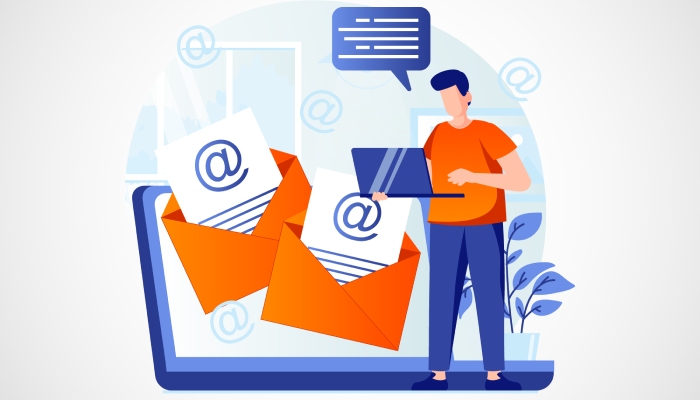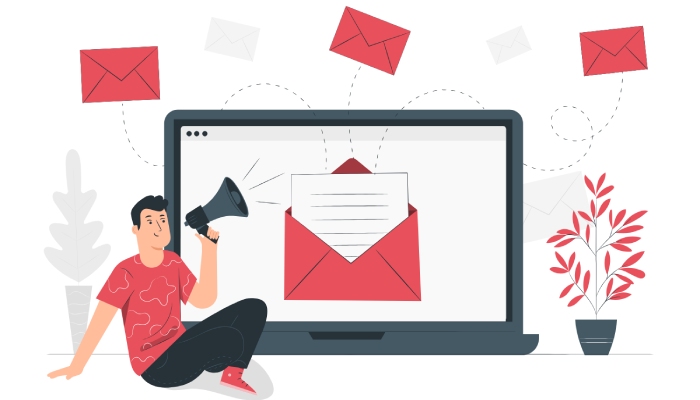Email Warm Up: Essential Strategies for Better Inbox Deliverability
In the digital age, email communication remains a vital tool for connecting with customers and potential clients. However, if you’ve ever found your carefully crafted messages mysteriously ending up in spam folders, you’re not alone. Many people overlook the crucial step of warming up their email accounts—kind of like how you wouldn’t jump into a cold pool without first getting used to the temperature.
Email warm-up is essential for building a solid sender reputation, ensuring that your emails land where they belong: in the inbox. In this article, we’ll explore effective strategies for warming up your email outreach and improving your chances of successful communication. Let’s dive into the essential steps that can make all the difference in your email deliverability.
Email warm-up is the gradual process of establishing a good sender reputation for an email account, which enhances its deliverability by reducing the chances of emails being marked as spam. This practice is crucial for marketers and businesses who rely on cold emailing campaigns, as it ensures that their messages reach the intended recipients’ inboxes instead of being filtered out.
What is Email Warm-Up?

Email warm-up essentially serves as a foundational strategy for anyone looking to optimize their email outreach. Imagine your email account as a new plant that needs nurturing to thrive. If you try to plant it in hardened soil without any precursor care, chances are it won’t flourish.
Similarly, when introducing a new or dormant email account to the digital landscape, it’s crucial to build its credibility gradually. This process helps avoid the dreaded spam filters lurking in the depths of email servers, ensuring your messages reach intended recipients rather than being lost in the void.
Building Trust
The initial phase of this warm-up journey often involves sending very few emails—typically just 5 to 10 per day—to establish legitimacy. Think of it like building trust in any relationship. The goal is to engage with real recipients, eliciting replies and interactions that signal to email service providers (ESPs) that your account isn’t a bot or a spam generator attempting mass mailing. Rather, it’s an authentic entity reaching out to people.
Just as a rookie pitcher would never start an entire game on their first outing, your fresh email account shouldn’t dive headlong into high volumes of outreach without establishing some rapport first.
Once your account has demonstrated consistent and positive engagement, it’s time to progressively ramp up your emailing activities.
Methodologies
The methodology behind email warm-up revolves around intentional growth; starting small is essential, with an increase in the volume of emails over time. For instance, you might kick off by sending emails to 10 contacts on the first day and then ramping up to 20 on day two before eventually reaching up to 50 or even 100 daily in subsequent weeks.
However, consistency is key throughout this process; if there’s an unexpected spike in activity—say jumping from 20 to 200 emails—this can raise red flags for spam filters and potentially jeopardize the account’s credibility.
By maintaining a steady pace and engaging genuinely with recipients—perhaps by encouraging replies or initiating meaningful conversations—you’re building not only your reputation score but also enhancing inbox placement rates significantly. Studies highlight that accounts adhering to these gradual warming processes can see as much as a 30% increase in their chances of landing directly in an inbox rather than being relegated to spam folders.
Understanding and executing effective warm-up strategies can spell the difference between success and frustration in your deliverability efforts. Let’s now turn our attention to the pivotal reasons behind adopting these practices.
Importance of Warming Up Your Email

At the heart of email communication lies trust—trust between sender and recipient. When an email account isn’t warmed up properly, it raises flags for spam filters, leading to deliverability issues.
In fact, statistics reveal that a staggering 45% of emails from new accounts get classified as spam without appropriate warm-up strategies in place. This means that one could pour resources into creating a powerful marketing campaign only to discover that nearly half of their carefully crafted messages are lost in the abyss of junk folders. What a disappointing reality!
Avoiding Spam Filters
The first crucial step in warming up your email account is to avoid these spam filters altogether. These systems are designed to protect users from unwanted mail but can be overly aggressive toward new senders.
A gradual approach is necessary; starting with smaller volumes of emails and increasing over time allows the system to recognize your email address as credible rather than suspicious.
Indeed, many seasoned marketers have learned this lesson the hard way. They often share cautionary tales about the consequences of neglecting email warm-up techniques. The importance of consistent and steady interaction with recipients serves as a hallmark of genuine engagement rather than spammy chatter.
Building Reputation
As you work towards building your email’s credibility, developing a positive sender reputation becomes critical. A well-warmed email account invariably leads to higher open rates and click-throughs.
When recipients see your name in their inbox, they’re more likely to perceive it positively if you’ve laid the groundwork through thoughtful engagement. This notion is echoed by many industry experts who remark, “Trust is built email by email, day by day.”
The impact goes beyond just ensuring successful delivery; it creates an inviting environment for future correspondence and builds lasting relationships with your audience.
A good reputation isn’t simply given; it’s earned through consistent performance—so investing in warm-up practices ensures greater long-term success for your campaigns. A reputable sender enjoys lower bounce rates and better deliverability because inbox providers look favorably upon accounts that demonstrate reliability.
Recognizing these fundamental aspects allows businesses to tailor their email strategies effectively, setting the stage for an actionable plan that promotes efficient inbox integration.
Step-by-Step Guide to Email Warm-Up

To ensure that your emails land in inboxes and not spam folders, following a structured approach is crucial. Start with a systematic method that allows for gradual improvement of your sending reputation.
Step 1 – Start with a Few Contacts
Begin your journey by reaching out to a small, manageable group of trusted contacts. These recipients should be individuals likely to open and interact positively with your email. Think of it like dipping your toes into the water before taking a full plunge into the pool. This helps build initial trust and engagement, which is pivotal for laying down a solid foundation for your sender reputation.
Step 2 – Track Engagement
As you send out those first few emails, careful tracking becomes vital.
Monitor these initial communications closely; pay attention to metrics such as open rates, replies, and any bounces or non-delivery reports. Engaging tools like EmailWarmupApp provide comprehensive analytics that track how well your emails are performing. Understanding where you stand regarding engagement helps you gauge your next steps more effectively.
Step 3 – Gradually Increase Volume
If the initial engagement looks promising, it’s time to ramp things up progressively. Start by slowly increasing the volume of your emails each day. For instance, you might begin with 10 emails on Day 1, then incrementally raise this number based on positive responses—20 on Day 2, then perhaps up to 30 or more as engagement continues to flourish. This method ensures that you’re scaling thoughtfully while allowing time for your sender reputation to strengthen without overwhelming your contacts.
Step 4 – Mix Content Types
Keeping your string of communications varied is equally important to broaden your reputation.
Sending different types of messages—including newsletters, personal introductions, or transactional emails—can help establish a well-rounded sender identity. This variation keeps recipients engaged and demonstrates that you’re not just pushing sales pitches into their inboxes. By delivering value in different formats, you’re crafting a multifaceted picture of yourself as an email sender.
- Day 1-5: Begin with 10-20 emails per day.
- Day 6-10: Ramp up to approximately 30-40 emails daily.
- Day 11-15: Aim for around 50-75 emails per day.
- Beyond: Proceed with gradual increments based on the positive engagement you’ve established thus far.
These measured steps create a strong foundation for future engagements, helping avoid pitfalls that can lead to poor deliverability rates and damaged sender reputation over time. Building on this strategy will pave the way for more effective outreach initiatives ahead.
Effective Warm-Up Strategies
Achieving effective email warm-up requires smart strategies to maximize engagement and ultimately raise your sender reputation. One of the most powerful possibilities at your disposal involves leveraging automated tools. Tools like Mailwarm and Warmup Inbox can revolutionize your approach by automating the send-and-response cycle within their networks of warm-up participants.
Think of these platforms as friendly assistants, tirelessly working behind the scenes, sending out emails and ensuring they receive responses.
Utilizing these tools not only saves you valuable time but also establishes a level of consistency that manual efforts simply can’t match. Consistency is key—it tells email service providers that your account is active and reliable.
Now, while automation is fantastic, it’s crucial to remember the importance of content strategy.
Content Variation
Diversifying your email content can play a significant role in the success of your warm-up efforts. Instead of sending out identical messages over and over again, make an effort to include a mix of newsletters, promotional offers, and personal emails. This variety prevents your correspondence from feeling robotic or spammy.
One user reflected on their experience, sharing, “Mixing content types increased my open rates by 35%.” This testimonial underscores the impact that varied email content can have in engaging recipients and building credibility. It fosters connection by moving beyond mere transactional communication to address recipients more personally and genuinely.
Moreover, authenticity plays a crucial role alongside content diversity.
Authentic Interactions
At the heart of effective email engagements lies the ability to foster authentic interactions. Crafting personalized messages tailored to your audience can significantly increase response rates. When recipients feel that an email is specifically meant for them rather than a generic blast campaign, they are more likely to engage positively.
An excellent approach is to encourage replies or discussions within your emails. Engaging with your audience builds rapport, sending strong signals to email service providers about your credibility as a sender.
A small yet powerful practice is to invite questions or feedback within your messages; when people respond, it’s not just about interaction—it’s about establishing long-term relationships that pave the way for successful communication down the line.
As we explore these strategies together, nurturing relationships takes time and patience—but every small step accumulates, enhancing your email deliverability over time. With this foundation laid out, we can now turn our attention to some standout solutions that can simplify your warm-up process even further.

Recommended Email Warm-Up Tools
Today’s marketplace boasts a strong lineup of email warm-up tools designed to enhance your inbox deliverability. Understanding their features, pricing, and how they perform can help you identify which one suits your needs best. Below are some popular tools you should consider:
| Tool Name | Features | Pricing |
| Warmup Inbox | Automated warm-up, daily reports | $15/month |
| Mailwarm | Comprehensive dashboard, API | $69/month |
| Lemwarm | AI-driven insights, user-friendly | $29/month |
| Folderly | Integration with major email apps | From $200/month |
| Warmy | Real-time analytics, 24/7 support | From $49/month |
Among these options, Warmup Inbox stands out as a favorite for many due to its seamless setup process and daily performance reports. It automates much of the hard work for you, ensuring that your sending reputation grows without needing constant monitoring. For those looking to gain deeper insights into data, Mailwarm offers a comprehensive dashboard alongside robust API access. This feature is especially beneficial for developers seeking to integrate warm-up strategies into broader app functionalities.
However, one must carefully evaluate each tool based on specific business requirements and budget constraints. For instance, if you’re just starting with a limited budget but want effective results, Lemwarm comes at an affordable rate while still providing AI-driven insights that can significantly enhance your success rates.
Remember: The price of a tool doesn’t always reflect its value. A simpler interface with essential features might be more advantageous than an expensive tool packed with unnecessary extras for your current needs.
The objective is to create a harmonious blend of functionality and cost-efficiency tailored to your unique emailing environment. As you refine your approach to email marketing, it’s also crucial to remain aware of potential pitfalls that could undermine your efforts. Let’s explore those challenges next.
Common Mistakes to Avoid
Even the best-laid plans can go awry if common pitfalls aren’t avoided. One mistake that many overlook is engagement metrics. Monitoring key engagement metrics, such as open rates and bounce rates, is essential. Failure to track these can lead you down a path of confusion.
Think of it like driving without a map—eventually, you might find yourself lost in the spam folder wilderness. Ignoring these metrics hinders your strategy and jeopardizes your credibility as a sender. If folks aren’t opening your emails, there’s a high chance they won’t be delivered next time.
Another pivotal mistake is scaling too quickly. Increasing your email volume too rapidly can raise red flags for email service providers. For instance, consider the story of one user who jumped from sending 10 emails to over 1,000 in just a week, leading to an alarming drop in deliverability that took time to recover from. Gradual increases in email volume signal to ISPs that you’re a legitimate sender and not engaging in spammy practices.
As we move on, remember that maintaining balance is key—diligence should guide your actions.
Ignoring Compliance
It’s imperative to comply with regulations such as GDPR and CAN-SPAM. These laws are designed to protect user privacy and ensure ethical communication practices. Ignoring compliance can lead to penalties and significant damage to your reputation as a sender. Always include clear unsubscribe options in your emails; this respects recipients’ choices and builds trust with your audience.
Lastly, don’t neglect the importance of authenticating your domain through SPF, DKIM, and DMARC protocols. Studies show that around 75% of unauthenticated emails are likely to be flagged as spam. Proper authentication assures ISPs that you’re who you say you are, enhancing your chances of landing in the inbox rather than the dreaded spam folder.
By sidestepping these common mistakes—monitoring engagement metrics, scaling responsibly, ensuring compliance, and authenticating emails—you’re setting yourself up for a more successful warm-up process and better inbox deliverability overall.
In summary, knowing what traps to avoid prepares you for effective email strategy development while enhancing delivery outcomes. Adopting these strategies will lead you closer to greater success in your email endeavors.
How long does the email warm-up process typically take?
The email warm-up process typically takes about 4 to 6 weeks to effectively establish a positive sender reputation. During this period, gradually increasing email sending volumes while maintaining high engagement rates is crucial; studies show that accounts with a consistent warm-up process can experience up to a 30% improvement in inbox deliverability compared to those that skip this step.

What metrics should be monitored to evaluate the success of an email warm-up?
To evaluate the success of an email warm-up, key metrics to monitor include open rates, click-through rates (CTR), bounce rates, and sender reputation scores. High open and CTR indicate engaged recipients, while low bounce rates suggest effective list hygiene. For instance, research shows that a well-executed email warm-up can increase deliverability by over 90%, significantly improving overall campaign effectiveness. Monitoring these metrics will help ensure your emails land in the inbox rather than the spam folder.
Are there any tools or services that can assist with the email warm-up process?
Yes, there are several tools and services designed to assist with the email warm-up process, such as Mailgun, Warmup Inbox, and SendGrid. These platforms automate the sending of emails to help establish a positive sender reputation through gradual engagement with real users. According to various studies, effective warm-up processes can improve inbox deliverability rates by up to 30%, ensuring that your emails land where they should—right in the recipient’s inbox rather than the spam folder.
What mistakes should be avoided during the email warm-up phase to ensure effective outcomes?
During the email warm-up phase, avoid mistakes such as sending too many emails too quickly, which can raise red flags with ISPs and lead to being marked as spam. Additionally, ensure that your email list is clean and engaged; sending to unqualified recipients can hurt your sender reputation.
According to studies, 20% of emails sent to inactive users can result in significantly lower deliverability rates, underscoring the importance of a strategic, gradual increase in volume and maintaining list hygiene for effective outcomes. Using a platform like Nureply can help streamline this process by automating warm-up schedules and supporting list hygiene best practices.
What specific steps should be taken during an email warm-up process?
The email warm-up process involves gradually increasing your sending volume over a period of time, starting with small batches of emails to engaged recipients. Begin by sending emails to your most active contacts, ensuring high open and response rates, which can boost your sender reputation.
It’s recommended to increase the volume by about 10-20% each week, aiming for consistency. According to studies, accounts that follow a structured warm-up process see up to a 30% increase in deliverability rates compared to those that send large volumes immediately. This incrementally builds trust with ISPs and improves inbox placement.



